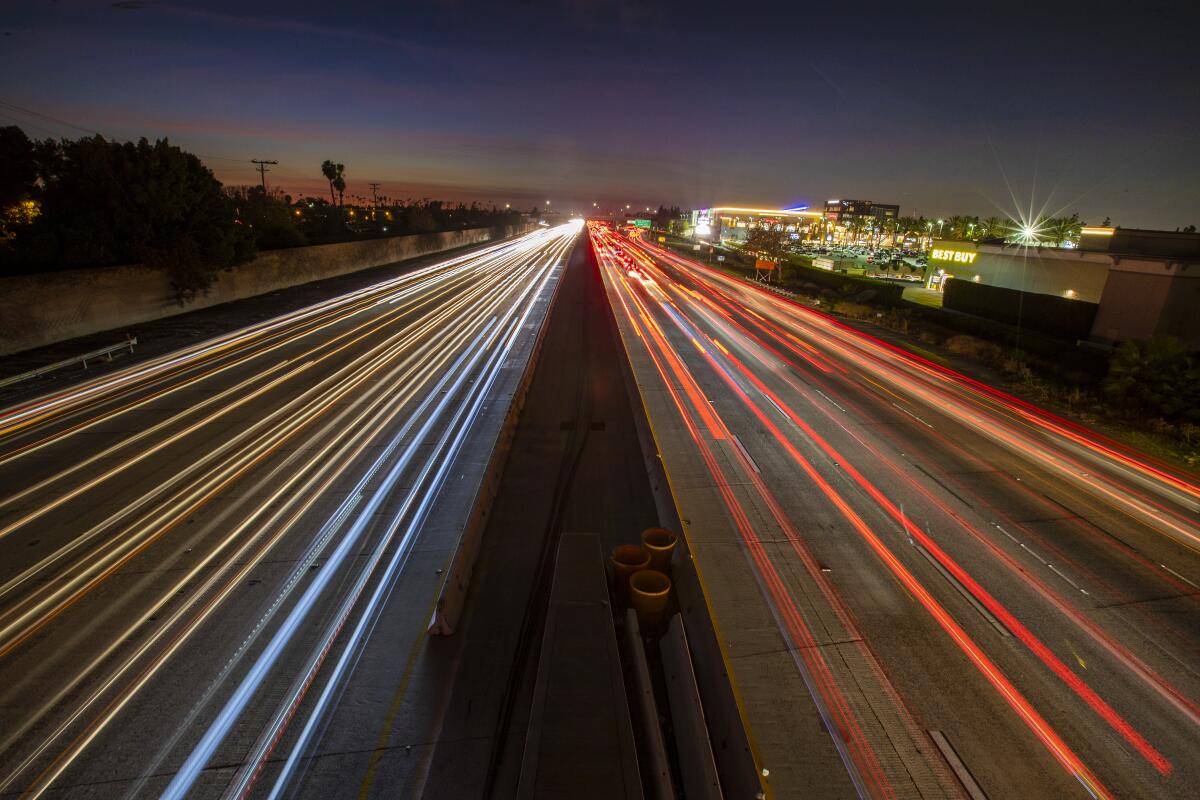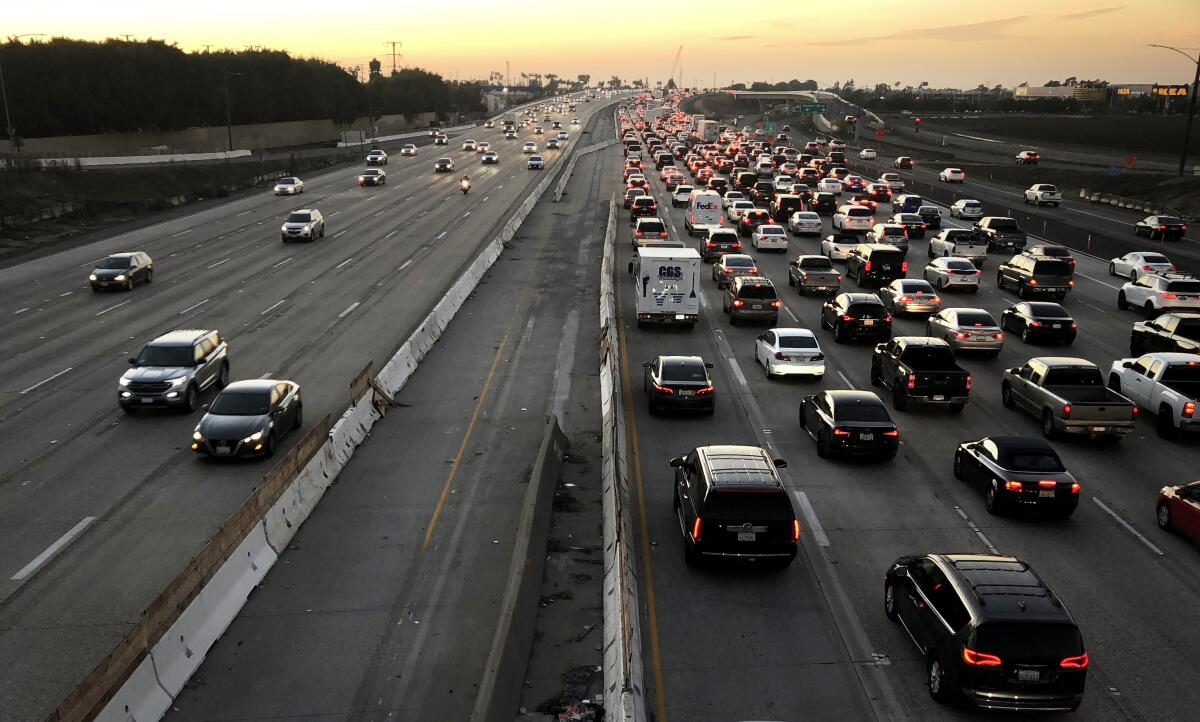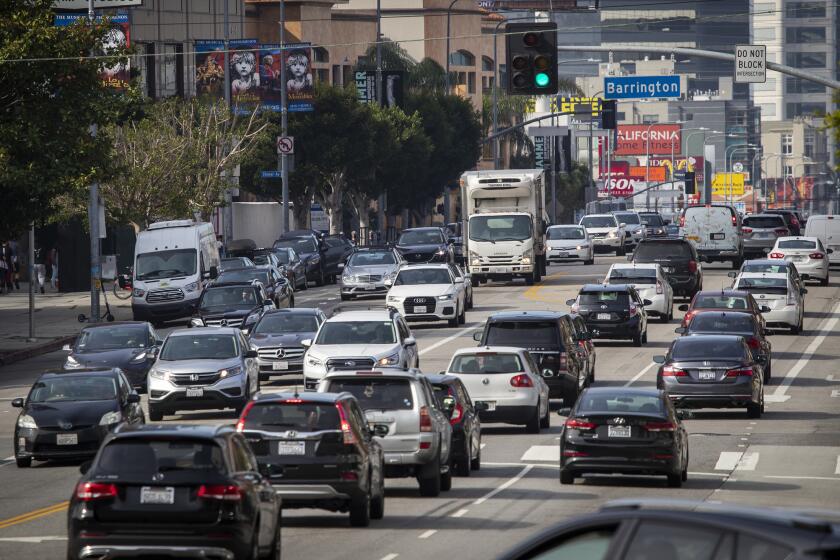A toll lane future is inevitable in California as traffic congestion worsens

When California began building its freeway network after World War II to connect its booming suburbs, the expectation was that drivers would be able to use them to speedily bypass traffic lights, pedestrians and increasingly congested city streets.
And while not expressly stated, the flowing concrete ribbons would be unlike the toll roads in the East: That is, these roadways would be free.
But that was long before those freeways became congested with bumper-to-bumper traffic, making for miserable commutes and perpetually smoggy skies.
Now, California is expanding toll lanes on freeways like never before, not just to raise revenue for transportation projects but to change behavior as well.
Toll lanes are in the works along the 405 Freeway in Orange County, the 15 Freeway in Riverside County and Interstate 880 in Alameda County.
Orange County is considering a huge expansion of toll lanes, eyeing the 55, 57 and 91 freeways as possibilities. Darrell E. Johnson, head of the Orange County Transportation Authority, said the plan is part of a decades-long, $43-billion investment in the county’s transportation network.
L.A. County officials are even considering adding toll lanes to the 405 in the congested Sepulveda Pass, and later, on the 105 and 605 freeways. Another proposal would add toll lanes to the 5 Freeway between Red Hill Avenue and the L.A. County line, costing $223 million to $779 million, according to Caltrans.
The moves have sparked opposition, with some saying drivers should not have to pay tolls in the lanes after already paying for the construction of the freeways themselves through taxes.
But there is increasing consensus that high-occupancy toll lanes -- which reserve certain parts of freeways to carpools and solo drivers paying tolls -- are a key solution. They bring needed revenue for new transportation projects while also putting a higher price tag on driving solo.
Michael Manville, an associate professor of urban planning at UCLA, said those who can afford to pay the fees are able to avoid congestion for a reliable daily commute, while presumably lessening traffic for those who don’t pay and use the general lanes, he said.
“What happens on the 405 every day is what happens at Best Buy and Target on Black Friday,” he said. “People who study congestion have known for a long time that the only thing [that will relieve congestion] is dynamic pricing.”
According to a recent study by the Southern California Assn. of Governments, a $4 fee to drive into a 4.3-square-mile area of West Los Angeles during weekday rush hour could almost immediately reduce traffic delays and miles driven there by more than 20%.
The decrease in traffic would correspond with a 9% increase in transit ridership, a 7% increase in biking and a 7% increase in walking inside the zone, according to the study.
State and federal goals to reduce the effects of climate change have contributed to the explosion of toll lane projects across California.
Gov. Gavin Newsom recently issued an executive order to spend money on projects that reverse the effects of greenhouse gas emissions associated with transportation. Since then, it has become more difficult to get approval on projects that don’t reduce greenhouse gases, said John Standiford of the Riverside County Transportation Commission.
About a decade ago, the Los Angeles County Metropolitan Transportation Authority, or Metro, received a $210-million congestion-reduction demonstration grant from the U.S. Department of Transportation, which was used to convert 11 miles of carpool lanes on the 110 Freeway and 14 miles on the 10 Freeway into price-managed express lanes, Metro spokesman Rick Jager said.
According to the OCTA, 75% of carpool lanes in Orange County are congested during rush hour and the lanes fail to meet federal standards mandating that vehicles move at a minimum of 45 mph 90% of the time in peak hours. The rule was made about a decade ago after California legislators wanted to allow solo drivers of electric vehicles to use the carpool lanes.
As electric vehicles have grown in popularity, carpool lanes across the state have become more clogged, said Joe Rouse, chief of Caltrans’ Office of System Operations.
Traffic has been exacerbated by the imbalance of jobs and housing in some areas, said John Goodwin, a spokesman for the Metropolitan Transportation Commission in San Francisco. The Bay Area, for instance, lacks adequate housing in its two major job hubs — Silicon Valley and San Francisco — making for longer commutes from the suburbs.
Highways in the Bay Area — known as the electric vehicle capital of California -- have a less-extensive carpool lane network than other parts of the state. That means electric vehicle drivers are flooding carpool lanes for free.
Add to that congested mix other solo drivers who cheat the system and the express lanes can become one big bottleneck. More than 25% of carpool lane users in the San Francisco transportation agency’s jurisdiction are solo drivers illegally using the lanes, Goodwin said.
Officials are now cracking down on cheaters to make the system more effective. In Los Angeles County, Metro is installing cameras that can detect vehicle occupancy and bill drivers delinquency fees if they violate toll road rules, Jager said. The camera system will be in operation in January. Other agencies are doing the same.
“We’ve been giving away precious space on the freeways for too long,” Goodwin said.
Experts agree the move toward more toll lanes is long overdue. While Orange County is in the early stages of planning, other parts of the state are less than a decade away from new toll lanes.
In San Mateo County, an extension for toll lanes on Highway 101 is under construction and is expected to be complete in 2022.
The Highway 237 corridor in Sunnyvale has just undergone 20 months of construction for an added seven miles of express toll lanes.
Caltrans also is exploring the possibility of building toll lanes on Interstate 80 in Sacramento, which could be under construction as early as 2023, according to reporting by the Sacramento Bee.
Charging drivers a fee to reduce traffic jams has worked in London, Milan and Stockholm, and the idea is gaining ground in New York.
In Orange County, toll lanes on the 91 Freeway save commuters using those lanes up to 30 minutes of travel time per day, according to the OCTA. Though transportation officials say drivers in the general lanes are also saving time, it’s unclear how much.
Despite the seeming benefits, officials know earning the public’s support for express lane projects is an uphill battle.
Orange County residents say the toll lanes are economic discrimination and would unfairly charge drivers for highways they already paid for with taxes.
Denise Colber of San Clemente is part of an online group of residents who consistently write letters to local officials opposing the toll lanes. She was outraged to learn that Orange County was adding even more lanes.
Like some critics, Colber calls them “the Lexus lanes.”
“It’s sad to say, but it’s becoming that,” she said. “A lot of my friends have moved to Texas, Arizona, Florida. Not everyone can afford it. That’s not fair.”
But transportation experts dispute the notion that toll lanes are unfair to low-income earners.
“No one who was driving for free is now not driving for free. It is just an extra option rather than a new burden on motorists,” Manville said.

Manville noted that because toll lanes generate more revenue than other transportation projects, they could theoretically allow for subsidies for low-income drivers.
The poorest communities are also the most affected by pollution caused by stop-and-go traffic and idling on cramped freeways, he said.
Although high-income earners use the toll lanes more regularly, middle- to low-income drivers benefit more from using toll lanes from time to time, according to a study by the University of Washington.
Wealthy people who use the toll lanes often make up 10% of all users, while 90% are middle-income earners who use the lanes only when it is most beneficial, “such as when a $10 peak toll is worth paying to avoid a $20 day-care late fee,” according to the study.
“Assuming that these findings are representative of priced express lanes in general, this study should serve to put to rest the ‘Lexus lanes’ canard once and for all,” researchers said.
Colber, who regularly carpools to work, said she fears that if the carpool lanes on the 5 Freeway are converted to toll lanes, she no longer would be able to use the portion of freeway she paid to build with taxes from Measure M.
Now known as the OC Go program, the measure allocated $13 billion to improve transportation in the county over 30 years. That included adding the carpool lanes on the 5.
Asked about this possibility, Caltrans spokesman David Matza said: “We see this project as a complement to what OCTA is doing. We don’t see it as breaking the promise. We’re not going to do anything without consulting not just OCTA but all our local partners.”
James Moore, director of USC’s transportation engineering program, said drivers have resisted toll roads since their inception and the thoroughfares have been a subject of “political terror.”
“People tend to view prices as the enemy of wealth,” he said. But that’s not the case. In reality, Moore said, toll roads are a no-brainer that will simply take time to get used to.
“It may never feel good to people emotionally to have to pay for something twice,” Moore said. “But I think they will get used to the benefits.”
More to Read
Sign up for Essential California
The most important California stories and recommendations in your inbox every morning.
You may occasionally receive promotional content from the Los Angeles Times.












